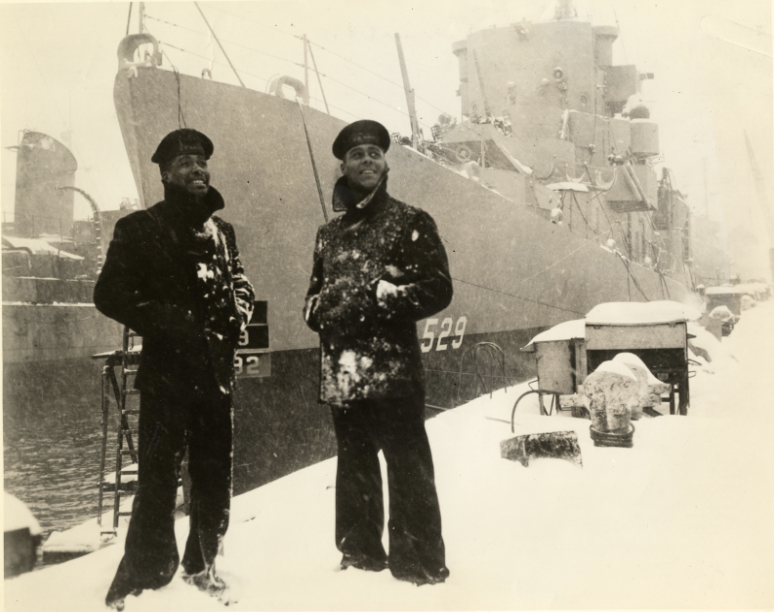Brief Discussion on Segregation and African American Contributions to the War Effort During World War II
by: Hannah Marcel
The past couple of weeks I have been assisting the museum technician with re-establishing the collections Integrated Pest Management (IPM) plan. Having an IPM plan in place protects historical and cultural resources against potential damage caused by pests. Pests include insects or rodents that may feed on or nest in objects, but also moisture pests like mold. Monitoring for these pests is an important part of an IPM plan. This includes setting traps to identify which pests may be in your collection and where they are located. This allows you to take further action in protecting other artifacts in the collection by preventing the spread of the pest and deciding the best course of action in eradicating them. It also gives you a better idea of how to protect against these pests in the future. By changing and monitoring these traps, I am learning what to look out for in order to keep a collection safe.
Another project that I have been working on is planning a collection show and tell program for park staff and volunteers. This would give them a chance to see objects in the collection that are not typically seen and broaden their understanding of the parks cultural resources and the ways that these are maintained. They can use the collection as a resource in their research and interpretation as well. This program will also allow them to understand when and how to connect members of the public with the cultural resource management team for personal research questions or artifact donation questions. To begin preparing for this program I have been working on identifying objects in the collection that may be of interest to the staff and volunteers. After identifying certain objects, research into the history and context of the objects provide a better picture of the ways that they connect to the daily work of volunteers and staff here in the park.
Dive Deeper
The Charlestown Navy Yard, and the USS Cassin Young, have been witness to changes in society and policy throughout history. The Second World War impacted every aspect of American life, including race relations. The experiences of those that worked in the Navy Yard, or served on the Cassin Young, is reflective of these cultural shifts. The Charlestown Navy Yard was established in 1800 at a time when slavery, although illegal in Massachusetts, was still practiced in most of the country. When the USS Cassin Young was commissioned in 1943, the Navy was still segregated. African American men and women made incredible, yet often overlooked, contributions to the war effort all while facing segregation and discrimination at home.
Prior to the Second World War, African American enrollment in the Navy was actively discouraged. Selective recruiting allowed the Navy to maintain a low number of African American soldiers who were only permitted to serve as stewards. A nation at war needs manpower, however, and the Navy was faced with increasing pressure from political activists to open all branches of the Navy to African Americans. After the United States joined the war they decided to do just that, with the exception of the Women’s Naval Reserve. African American women would not be permitted to join until late 1944.
African American enlistees trained in segregated facilities, lived in segregated berthing, and were barred from restaurants and bars that their white counterparts could visit. On the USS Cassin Young, African American soldiers were berthed in the small closet sized room that would later be converted into a barbershop space. Only 10% of a ships crew was permitted to be African American, leaving most enlistees to work on land as construction and dock workers. The Navy pointed to a lack of segregated berthing options onboard as a reason for these restrictions. Political pressure continued to grow, however, and the Navy decided to commission a ship specifically for African American soldiers.
 The USS Mason was built here in the Navy Yard and held an almost entirely African American crew. Serving as an escort ship the USS Mason assisted more vulnerable ships across the North Atlantic, navigating storms and German U-Boats. During a particularly brutal storm, the crew escorted the more vulnerable ships in their convoy to safety. When other ships sent to help turned back to harbor, and the storm cracked their deck, the men of the USS Mason repaired the deck and continued to help. The men went above and beyond to serve their country despite racism and segregation they experienced back home. As a result of their bravery the captain of the USS Mason recommended the crew receive a commendation for their efforts but this request was ignored. In 1994 President Clinton recognized the bravery of these men with a commendation, presented to 67 surviving members, after the story of the USS Mason resurfaced.
The USS Mason was built here in the Navy Yard and held an almost entirely African American crew. Serving as an escort ship the USS Mason assisted more vulnerable ships across the North Atlantic, navigating storms and German U-Boats. During a particularly brutal storm, the crew escorted the more vulnerable ships in their convoy to safety. When other ships sent to help turned back to harbor, and the storm cracked their deck, the men of the USS Mason repaired the deck and continued to help. The men went above and beyond to serve their country despite racism and segregation they experienced back home. As a result of their bravery the captain of the USS Mason recommended the crew receive a commendation for their efforts but this request was ignored. In 1994 President Clinton recognized the bravery of these men with a commendation, presented to 67 surviving members, after the story of the USS Mason resurfaced.
 African American women who contributed to the war effort also faced segregation and discrimination on the homefront. African American WAVES were trained separately from their white counterparts and were sometimes given less desirable jobs. When women all over the country took jobs in factories and navy yards to support the war effort, African American women were barred from many of the jobs. They often faced harsh treatment from their bosses and discrimination from their white counterparts. The hypocrisy of a nation fighting the white supremacist ideals of the Nazi regime while treating their own citizens as inferior based on their race was obvious to many. In 1942, the Double V Campaign emerged, advocating for a double victory for African Americans, one abroad and one at home.
African American women who contributed to the war effort also faced segregation and discrimination on the homefront. African American WAVES were trained separately from their white counterparts and were sometimes given less desirable jobs. When women all over the country took jobs in factories and navy yards to support the war effort, African American women were barred from many of the jobs. They often faced harsh treatment from their bosses and discrimination from their white counterparts. The hypocrisy of a nation fighting the white supremacist ideals of the Nazi regime while treating their own citizens as inferior based on their race was obvious to many. In 1942, the Double V Campaign emerged, advocating for a double victory for African Americans, one abroad and one at home.
The pressures of war forced barriers to break as the nation needed more manpower. The war effort brought individuals of all different backgrounds together and opened opportunities that had previously been unavailable to many Americans. African American men and women were able to obtain higher paying jobs than those available before the war. People of various backgrounds worked alongside people of different genders, races, class, and physical ability. In July of 1948 President Truman signed executive order 9981, requiring all armed services to begin the process of integration and declaring equal treatment an official policy.

During the Korean conflict, ships were fully integrated and pictures taken on the Cassin Young during the Cold War show white and African American soldiers together. The military, and the country, still had a long way to go. Many African American veterans that fought the white supremacist beliefs of Nazi Germany returned home and fought for Civil Rights in their own country. Despite this the contributions and experience of African American men and women during the Second World War and beyond have historically been ignored. As always the story goes deeper than what I am able to share here and I urge you to continue to research the stories of these men and women.
To read a more in depth post on the men of the USS Mason visit this blog post written by Mary Pat Kelly, https://www.americanheritage.com/uss-mason-battles-u-boats-and-bigots, or purchase her book Proudly They Served: The Men of the USS Mason.
To hear the stories of African American women working in World War II please visit https://www.invisiblewarriorsfilm.com/

